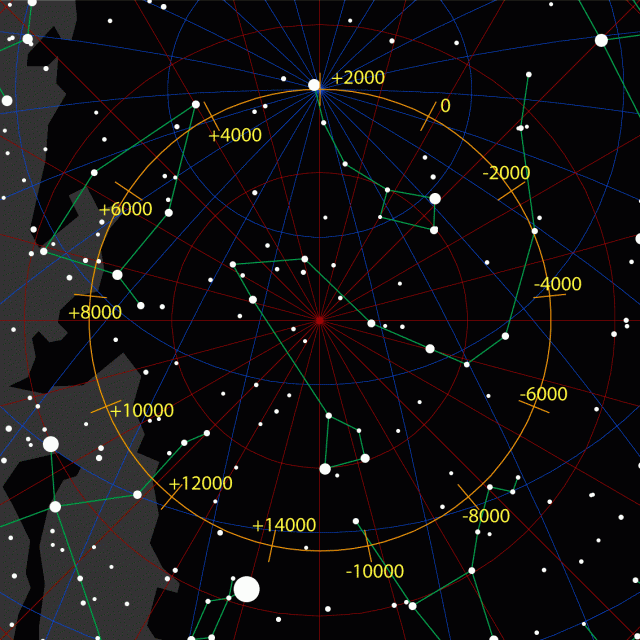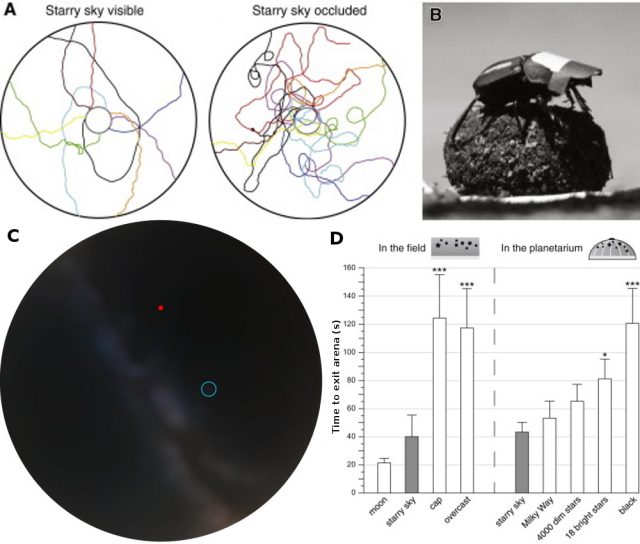On humans, birds and dung beetles: using stars for orientation

When the nymph Calypso was finally convinced by Hermes to let Odysseus go back to Penelope and his island, she gave the Greek hero very precise instructions. After leaving Calypso’s island, Ogygia, Odysseus should “keep [the Great Bear that men call the Wain] to larboard as he crossed the waters”. In the northern hemisphere, all stars seem to rotate around a fixed point in the sky, the celestial north pole, which marks the local north direction. The constellation of the Wain (Ursa Major) lays near the celestial north pole, even closer back then than in today’s sky. During the night it turns “round and round where it is, […] never dipping into the stream of Oceanus”. By keeping this constellation to larboard, Odysseus traveled east in a straight path and, eventually, he arrived to Ithaca in time to warmly thank everyone for respecting his wife and household during his absence.
This passage in the Odyssey is probably the oldest mention of the use of stars for navigation, but other examples can be found in the classical literature. Some of the most elaborate star compasses, such as the one developed by Polynesians and Micronesians to sail long distances between islands in the Pacific, were still in use many centuries after the adoption of the magnetic compass by other civilisations. Surprisingly as it may seem, other species have used the stars for navigation for longer than we did, and they still do.

Many migratory birds have extraordinary abilities to return after having been displaced—while preventing them to access any cues during the displacement—thousands of kilometers to unfamiliar territory 1. We now know that some of them use magnetic and celestial cues for orientation in unfamiliar environments 2. In the late 60s and 70s Stephen and John Emlen performed careful experiments in a planetarium, discovering that a small, the bird Indigo Bunting (Passerina cyanea), is able use the sky to orientate towards a preferred direction. Further experiments by Wiltschko and colleagues showed that juvenile Garden Warblers (Sylvia borin) raised under a rotating artificial sky learned by experience the point of celestial rotation, and that they later use it for orientation during the migration season. Those birds did not seem to hold innate ideas about patterns on the starry sky, patterns that anyway have changed during their evolution (see Figure 1).

Among insects we can find some unlikely nocturnal navigators. Dung beetles do not need to migrate to far-away lands, but they have to carry out the equally decent task of rolling excrement balls to a patch of soft earth, and burying them before they dry or they are stolen by another beetle. Just like a human, without any information about a direction beetles would start to walk in circles and they risk to find the right spot after their dung balls get too dry to lay their eggs on them.
Orientating with respect to any far away signal would help in this case. If Odysseus was only worried about escaping quickly from his lover and did not care at all about going back to Ithaca, choosing any star or the Moon as a reference would guarantee a reasonably straight path, for a couple of hours at least. However, dung beetles small compound eyes sacrifice some of their inherently poor spatial resolution for light sensitivity and possibly can not detect single stars. They are known to use the Moon instead, or the polarisation pattern it produces on the night sky. But what can dung beetles do on a moonless night?
In a recent article 3, Marie Dacke, Eric Warrant and their colleagues in Sweden and South Africa answered this question. They observed that African dung beetles (Scarabaeus satyrus) walked in a reasonably straight line under a moonless sky, but wandered aimlessly when the researchers occluded their view of the sky with small cardboard caps (see Figure 3, A and B). Dung beetles wearing similar but transparent caps kept a straight walk. It seems clear that the beetles are using some information from the starry sky for orientation.
But it seems unlikely that the dung beetle’s eye can distinguish single stars, so Marie Dackie and her colleagues tested whether they can detect their general distribution across the sky, which is not homogeneous as there are more stars across the band of the Milky Way. They made the dung beetles roll their balls under the artificial sky of a planetarium capable of separating the different celestial cues. The dung beetles followed reasonably straight paths when shown all the stars or when shown only a blurry streak of light imitating the Milky Way, but they were not able to walk straight when presented with the more homogeneous distribution of the brightest 4000 or 18 stars (Figure 3).

This article was awarded an Ig-Nobel prize this year because it is imaginative, it is fun and really opens a whole new world of possibilities. Now that we know that it does not take a human-like eye to orientate by the stars, insects and small amphibians will join the group of usual suspects that before comprised migrant birds and marine mammals. I would not be surprised if there is a world of Odysseus waiting to be discovered.
References
- K. Thorup and R. A. Holland “The bird GPS: Long-range navigation in migrants” J Exp Biol 2009 212:3597-3604. ; doi:10.1242/jeb.021238 ↩
- H. Mouritsen ”Navigation in birds and other animals” Image and Vision Computing 2001 19:713-731 ↩
- Dacke M., Baird E., Byrne M., Scholtz C. & Warrant E. (2013). Dung Beetles Use the Milky Way for Orientation, Current Biology, 23 (4) 298-300. DOI: 10.1016/j.cub.2012.12.034 ↩
1 comment
[…] joins in without realizing. They only stop when they are fully exhausted. Poor creatures. (Image source) 10. GOATS: If you have enough space for furry, cute little goats to graze around, then you may as […]